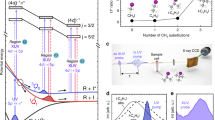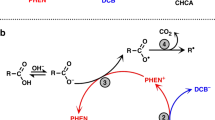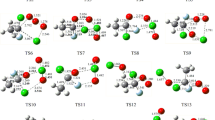Abstract
CHARGE-TRANSFER complexes are known as transient species in reactions of free radicals. This is because of the relatively high electron affinities of some radicals (Table 1). There are reports of solvent effects1 and of the vapour phase halogenation of aromatic compounds2 which show the possible influence of such complexes on reaction mechanisms. So far only very limited proof for the existence of these complexes is available. Charge-transfer complexes with iodine atoms3–5 and with bromine atoms6,7 as electron acceptors have been detected by flash photolysis and pulse radiolysis. This communication reports charge-transfer complexes of chlorine atoms seen during pulse radiolysis of carbon tetrachloride solutions of aromatics. In an earlier communication8 the typical behaviour of very short-lived transients (of the order of µsec) was reported. These have now been identified as charge-transfer complexes of chlorine atoms with aromatic solutes.
This is a preview of subscription content, access via your institution
Access options
Subscribe to this journal
Receive 51 print issues and online access
$199.00 per year
only $3.90 per issue
Buy this article
- Purchase on Springer Link
- Instant access to full article PDF
Prices may be subject to local taxes which are calculated during checkout
Similar content being viewed by others
References
Huyser, E. S., Adv. Free Radical Chem., 1, 77 (1965).
Kooyman, E. C., Adv. Free Radical Chem., 1, 137 (1965).
Rand, S. J., and Strong, R. L., J. Amer. Chem. Soc., 82, 5 (1960).
Strong, R. L., Rand, S. J., and Britt, J. A., J. Amer. Chem. Soc., 82, 5053 (1960).
Gover, T. A., and Porter, G., Proc. Roy. Soc., A, 262, 476 (1961).
Bartlett, J. C., Diss. Rensselaer Polytechnic Institute (1962).
Ebert, M., Keene, J. P., Land, E. J., and Swallow, A. J., Proc. Roy. Soc., A, 287, 1 (1965).
Bühler, R. E., Gäumann, T., and Ebert, M., Proc. Symp. Pulse Radiolysis 279 (Academic Press, London, 1965).
Keene, J. P., J. Sci. Instrum., 41, 493 (1964).
Bühler, R. E., Helv. Chim. Acta, 50 (in the press) (1967).
Briegleb, G., Elekronen-Donator-Acceptor-Komplexe, Springer (1961).
Moiseiwitsch, B. L., Adv. Atom. Molec. Phys., 1, 61 (1965).
Gaines, A. F., Kay, J., and Page, F. M., Trans. Farad. Soc., 62, 874 (1966).
Morrison, J. D., and Nicholson, A. J. C., J. Chem. Phys., 20, 1021 (1952).
Russell, G. A., Ito, A., and Hendry, D. G., J. Amer. Chem. Soc., 85, 2976 (1963).
Author information
Authors and Affiliations
Rights and permissions
About this article
Cite this article
BÜHLER, R., EBERT, M. Transient Charge-transfer Complexes with Chlorine Atoms by Pulse Radiolysis of Carbon Tetrachloride Solutions. Nature 214, 1220–1221 (1967). https://doi.org/10.1038/2141220a0
Received:
Issue Date:
DOI: https://doi.org/10.1038/2141220a0
This article is cited by
-
Formation of intramolecular dimer radical ions of diphenyl sulfones
Scientific Reports (2020)
-
Quantum yields of photosubstitution of the nitro group in nitrobenzene-tetrachloromethane mixtures
Journal of Radioanalytical and Nuclear Chemistry Articles (1984)
-
Negative temperature coefficients in chlorination reactions of unsaturated compounds in carbon tetrachloride
Theoretical and Experimental Chemistry (1975)
Comments
By submitting a comment you agree to abide by our Terms and Community Guidelines. If you find something abusive or that does not comply with our terms or guidelines please flag it as inappropriate.



